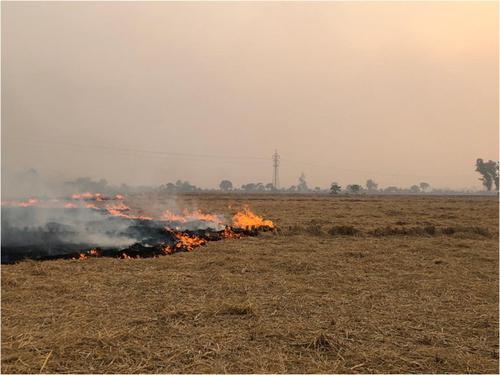Agronomy for Sustainable Development ( IF 7.3 ) Pub Date : 2022-09-02 , DOI: 10.1007/s13593-022-00817-0 Manpreet Kaur , Dharm Pal Malik , Gurdeep Singh Malhi , Virender Sardana , Nanthi S. Bolan , Rattan Lal , Kadambot H. M. Siddique

|
This paper reviews and analyzes the impact of residue burning on the environment and human health, and the influence of ex-situ and in-situ residue management on reducing pollution and improving soil health, crop yield, and farmers’ economic benefits. Paddy is cultivated on 43.8 Mha in India, producing 118.43 Mt grain and an estimated 165.8 Mt straw. Burning is the most common practice for managing rice crop residues mainly due to its simplicity, low cost, increased mechanical harvesting, short window between rice harvest and wheat sowing, and lack of viable uses for residues. Around 50 Mt of rice straw is burned annually, nearly half of which occurs in northwestern India during October/November. Burning residue is a major contributor to air pollution, emitting around 1.5 Mt particulate matter, 150 Mt carbon dioxide, and other greenhouse gases (e.g., NO2, SO2, CO, CH4, NH3) and volatile organic compounds, resulting in a wide range of respiratory infections in humans, reduced soil nutrient and carbon inputs, and disturbed soil microbial activity. In-situ residue management using a Happy Seeder, Super straw management system, paddy straw chopper cum spreader, reversible moldboard plow, or no-till seeder incorporates or mulches residues, avoiding burnings. These operations are economically profitable as they reduce costs, increase yields, or both. In-situ residue management, i.e., incorporation or mulching improves the soil’s physical, chemical and biological properties and is considered better for improving soil health than residue removal. Ex-situ residue management for biofuel, biochar, electricity generation or bale making is also profitable for the environment and reduces pollutant emissions.
中文翻译:

印度恒河平原稻谷残留管理以促进气候和粮食安全。回顾
本文回顾和分析了秸秆焚烧对环境和人类健康的影响,以及异地和就地秸秆管理对减少污染和改善土壤健康、作物产量和农民经济效益的影响。印度的水稻种植面积为 43.8 Mha,生产 118.43 Mt 谷物和估计 165.8 Mt 稻草。焚烧是管理水稻作物秸秆最常见的做法,主要是因为它简单、成本低、机械收割增加、水稻收获和小麦播种之间的时间短,以及秸秆缺乏可行的用途。每年约有 50 公吨稻草被焚烧,其中近一半发生在 10 月/11 月期间的印度西北部。燃烧残渣是空气污染的主要贡献者,排放约 1.5 Mt 的颗粒物、150 Mt 的二氧化碳和其他温室气体(例如二氧化碳)。2 , SO 2 , CO, CH 4 , NH 3) 和挥发性有机化合物,导致人类广泛的呼吸道感染,减少土壤养分和碳输入,并扰乱土壤微生物活动。使用快乐播种机、超级稻草管理系统、稻草切碎机兼撒布机、可逆式犁板犁或免耕播种机进行现场残留物管理,将残留物合并或覆盖,避免燃烧。这些操作在经济上是有利可图的,因为它们可以降低成本、提高产量或两者兼而有之。就地残留物管理,即掺入或覆盖可改善土壤的物理、化学和生物特性,被认为比清除残留物更能改善土壤健康。生物燃料、生物炭、发电或打捆的异地残留管理也对环境有利可图,并减少污染物排放。



























 京公网安备 11010802027423号
京公网安备 11010802027423号